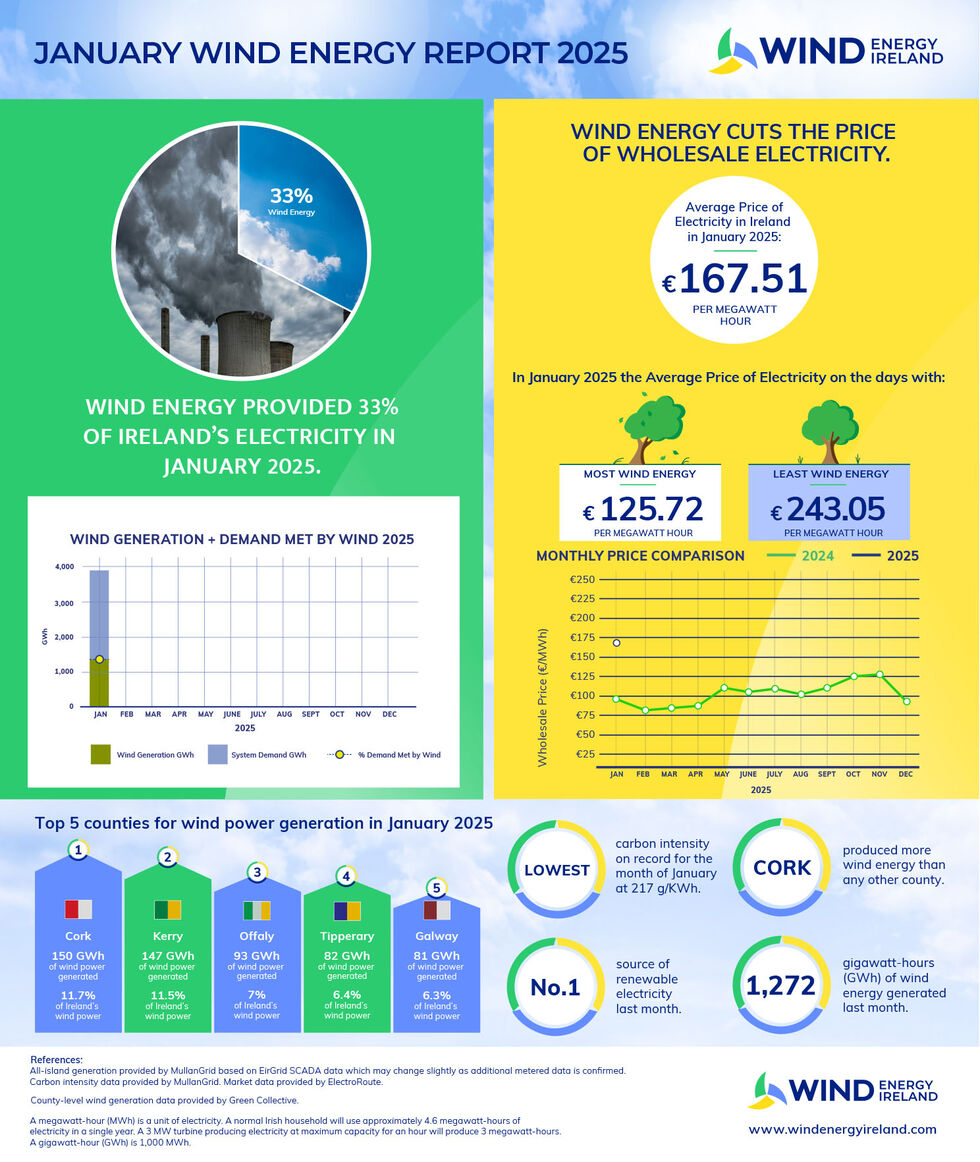Wind energy saved Ireland over €1.2 billion on gas in 2024
16 Feb 2025
- Ireland’s growing wind energy sector protected consumers from continued volatility in the gas sector throughout the year.
- The fossil fuel industry lost out on almost €905 million last year, with an additional €324 million saved on carbon credits, across the island of Ireland.
- A third of Ireland’s electricity came from wind energy in January 2025.
17th February: Spending on gas for electricity in Ireland was cut by almost one billion euro last year, as wind energy supplied 32 per cent of Ireland’s electricity. Irish wind farms saved €748 million euro on gas, which would have been predominantly imported, and a further €268 million in carbon credits in Ireland. An additional €213 million euro was saved on gas and carbon credits in Northern Ireland, bringing total all-island savings to more than €1.2 billion euro.
These figures come from the latest annual Cutting Carbon, Cutting Bills report from Baringa, which analyses the annual savings in gas consumption delivered by wind energy.
Electricity savings were particularly high in March, the strongest month for wind energy generation last year, and December, the month with the highest gas prices, with €120 million and €170 million saved respectively.
The displaced gas also meant a saving of 5 million tonnes of CO2 across the island, equivalent to the annual emissions of 1.8 million cars.
Noel Cunniffe, CEO of Wind Energy Ireland, said: “Once again this report highlights the critical role Irish wind farms are playing in driving down Irish energy costs, cutting our carbon emissions and reducing our reliance on imported fossil fuels.
“Rather than importing hundreds of millions of euro of gas, Irish wind farms ensured money stayed where it belongs, at home, supporting Irish workers and businesses."
However, further savings were prevented due to insufficient grid capacity which meant Ireland was unable to take full advantage of its windiest months.
Noel Cunniffe continued: “Last year Ireland reached record levels of wind energy generation capacity, with over 5,000 MW of onshore generation capacity now installed. However, it was also the worst year on record for the amount of wind power lost due to challenges with electricity grid capacity.
“Every time a wind turbine is shut down because the grid can’t take the electricity, it means higher bills and more carbon emissions. This report further highlights the urgent need to reinforce our grid infrastructure, so that we can get more wind energy on the grid and allow consumers to fully benefit from Ireland’s renewable transition.
“As we saw during Storm Éowyn, resilience of our electricity grid is key to meeting growing demand while ensuring a secure and sustainable energy future. We welcome the recent announcement by Minister Darragh O’Brien TD of new plans from the Government to strengthen our electricity grid to protect families and businesses vulnerable to these kinds of weather events.”
January wind energy report
In January 2025 wind continued to play an important role in Irelands energy mix as shown in Wind Energy Ireland’s monthly wind energy dashboard. Last month saw wind energy provide a third of Ireland’s electricity and a total of 1,272 GWh of electricity was generated.
The average wholesale price of electricity in Ireland per megawatt-hour was €167.51. On the windiest days, the cost of a megawatt-hour dropped to €125.72, while on days when Ireland relied almost entirely on fossil fuels, prices surged to €243.05, partly due to increases in gas prices in recent months.

County generation
Based on county level data provided by Green Collective, Cork led the country in wind energy production, generating 150 GWh, accounting for 11.7 per cent of Ireland’s wind power. It was followed by Kerry (147 GWh), Offaly (93 GWh), Tipperary (82 GWh), and Galway (81 GWh). January 2025 also recorded the lowest carbon intensity for the month at 217 g/kWh.
Meanwhile, electricity demand increased by 2 per cent compared to the previous year, likely due to a cold snap early in the month, though demand dipped following Storm Éowyn when many homes and businesses lost power.
Commenting on the January wind energy report, Noel Cunniffe said: “Last month was devastating for so many families and communities across the country who were without power for so long. Despite fantastic efforts by ESB Networks teams to restore power many tens of thousands of people were left without electricity for weeks.
“The immediate focus of State agencies has rightly been on restoring power to all homes and businesses. But the focus must move soon to building a more resilient electricity network to protect us from even fiercer storms in the future.
“Strengthening our grid infrastructure is a vital investment in our future. It will help to further protect our electricity supply and we look forward to working with the Government to support this work and deliver on our clean energy future.”
To read the full Baringa report, click here.






